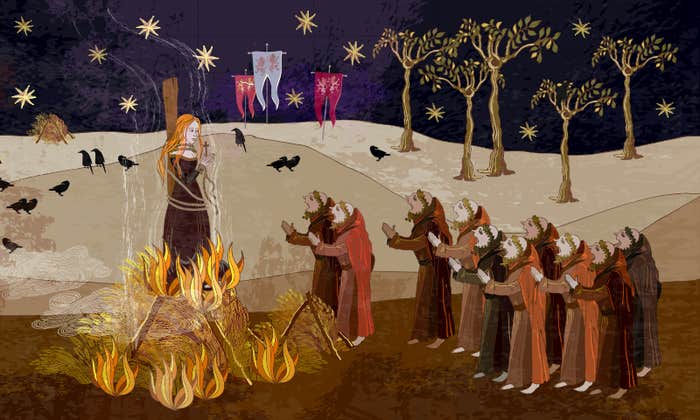In the 1970s, psychologist Irving Janis pioneered research into a phenomenon that goes by a name most people know, probably understand intuitively, and perhaps have experienced personally. I’m talking about “groupthink.” Janis saw the symptoms of groupthink in a host of bad collective decisions he studied. He was particularly intrigued by White House fiascos, like the Bay of Pigs invasion and the escalation of the Vietnam War, but also detected groupthink in the Challenger space shuttle disaster. Janis called it “a deterioration in mental efficiency, reality testing and moral judgements as a result of group pressures.”1
But when, exactly, does groupthink take hold and ruin a committee’s, a governing body’s, or a society’s decision-making process? How little independent thinking does there have to be for collective deliberation to go astray? And what role does rethinking your opinions play? A recent paper, by Vicky Chuqiao Yang and colleagues, published in the Proceedings of the Academy of Sciences, investigates these very questions.2
Yang is an applied mathematician who studies collective human behavior at the Santa Fe Institute, a place that brings together researchers of all stripes to advance complexity science. To figure out how collective decision-making between two options can land on the worse one, Yang’s team came up with a simple model that includes two types of learners—individual and social. Individual learners think for themselves while social learners take their cue from others. Yang says social learners are a “central concern” in social systems because some of the most urgent challenges humanity faces—like climate change and pandemics—require thinking and acting together to solve them. Social learners are a potential liability: “A key question concerning collective decisions is whether a social system can settle on the best available option when some members learn from others instead of evaluating the options on their own.”
It is not the social learners who are the problem here: Individual learners reluctant to change their minds are.
Yang’s model starts out with all of the learners, individual and social, holding random preferences between two options. Suppose you and 19 of your friends are trying to decide which movie to go see next weekend: Spider-Goat 4 or Long Wars XI. (Just to be clear, I made up those titles, not Yang.) Before anyone reads the reviews, half the group might favor one movie and half the other. However, 80 percent of online reviewers agree that Spider-Goat 4 has a better plot, better acting (especially the goat), and better special effects. As time goes on, the individual learners among your friends make their final decisions based on their own research, while the social learners make up their minds based on what they hear from others in the group. What are the chances that the majority will settle on the better-reviewed movie? Or, in Yang’s term, “the option with higher merit.”
The researchers played with a few variables: the proportion of social to individual learners in your group of friends, the proportion of individual learners who will eventually decide on, say, Spider-Goat over Long Wars, and the strength of the social conformity in the friend group.
That last factor depends on the different ways social learners can behave. Studies of some groups have observed a low strength of conformity, meaning that social learners will not change their minds unless the rest of the group overwhelmingly says they should. Researchers have described this as “informational conformity,” because the social learners appear to be waiting for the group to make an informed judgement. If many of your friends are busy people who care about movies but simply don’t have time to read all the reviews, they might be informational conformists.
Other studies have observed groups where the strength of conformity is high, meaning that social learners are easily swayed by the majority opinion. Being easily swayed is what’s called “normative conformity,” because the social learners seem to be more interested in group harmony than in making an informed judgement.
Let’s say that 10 people in your friend group are individual learners and 10 are informational conformists, and that 8 of the 10 individual learners eventually decide that they should see Spider-Goat. That means, according to Yang’s analysis, that the majority of the rest of the group will also eventually choose to see Spider-Goat, although the vote is likely to be closer to 50-50 than 80-20. In fact, this would be true even if the initial, uninformed opinions of the group favored Long Wars (based on the incredible performance of Joonas Suotamo in Long Wars X).
On the other hand, if the social learners in your group are easy-going slackers who just want to be mellow with their friends, the behavior of the group could be much more difficult to predict. Yang’s team showed that in this case, if the proportion of conformists is above a certain threshold, then the group becomes bistable: The final decision could depend on the uninformed initial opinions of the group and who changes their mind when. Perhaps, if 45 percent of your group initially favors Spider-Goat, it will win in the end, but if only 40 percent likes the idea to begin with, then Long Wars will win. Or perhaps Long Wars taking an early lead will convince enough social learners to vote for it that Spider-Goat can’t catch up (no matter how good the goat is). It is difficult or impossible to predict which one.
What people post matters more than which people see which post.
The balance between how strongly the conformists feel about seeing a good movie and everyone getting along, as well as the balance of the individual learners’ views, determines the number of social learners needed for bistable unpredictability. If the social learners are evenly balanced between normative and informational, then the group will predictably settle on Spider-Goat unless almost all of the learners are social. As the social learners lean more toward the “get-along” type, it takes fewer of them to tip the group into unpredictability.
In reality, probably none of us are pure “individual” or “social” learners. All of us likely do a bit of both. We’re also not equally influenced by others around us. Plus, sometimes, we can’t explain why we prefer one thing over another; we might change our mind on a whim. Yang and her colleagues reflected these truths in three slightly more complicated versions of their model. In each case the model performed similarly to the simpler one, with one exception. If the probability of an individual changing their mind at random is large, like 50 percent or more, the noise overwhelms the signal. The group will eventually reach an even split of opinions and never be able to decide on a movie.
Yang’s group also tried one more variation on the model. They made one of the options “stickier” than the other, meaning individual learners who favor it are less likely to change their mind regardless of the other learning effects. The psychologist Adam Grant in his book Think Again calls this “getting stuck on Mount Stupid.” “The single most important driver of [election] forecasters’ success,” he writes, “was how often they updated their beliefs.”
Probably none of us are pure “individual” or “social” learners. All of us likely do a bit of both.
You might, for instance, have a die-hard core of Long Wars fans who even liked The Rancid Menace and another group who have seen every Markel movie ever made and aren’t about to stop now. If the better-reviewed movie (Spider-Goat 4) is also stickier, then the model behaves as before. If Long Wars XI is stickier, however, the results are opposite. If the proportion of social learners is low, Long Wars will eventually prevail despite being worse. If the proportion is high, the bistable situation appears. Notably, it is not the social learners who are the problem here: Individual learners reluctant to change their minds are.
If these results—theoretical at this point, tested mathematically and with computer simulations—do in fact correspond to real life, what do they suggest? Many people have speculated that changes to social media, such as breaking echo chambers, making sure users see posts from people they disagree with, would improve the democratic process. However, the version of the model where every social learner is influenced by every other learner does not seem to behave much differently from the version which restricts the communication between learners. What people post matters more than which people see which post.
A critical number of people, in whatever sort of organization you have in mind, need to be evaluating the evidence for themselves, but they also need to be flexible about that evaluation. That’s because, as Yang and her colleagues found, “if an individual learner never changes their mind based on new evidence, their chosen option could spread throughout the social network.” And, for better or worse, this means that “committed minorities can have an important influence over the outcomes of democratic elections.”
Groupthink can be a form of intellectual laziness, but not all intellectual laziness has to lead to groupthink, and not all social learning is intellectually lazy. Yang’s group showed that informational conformity can be an effective strategy for decision-making with reduced effort, and even normative conformity can be effective in moderate amounts. The real problem is when group members are unwilling or unable to reconsider their opinions in light of new information.
Yang’s research shows that lack of rethinking spoils the success not just of individuals but of the groups they belong to. “The symptoms of groupthink,” Janis noted, “arise when the members of decision-making groups become motivated to avoid being too harsh in their judgments of their leaders’ or their colleagues’ ideas.” Successful groups encourage a culture where they, as Grant put it, “embrace the joy of being wrong,” and think again.
Joshua Holden is the Endowed Chair for Innovation in Science, Engineering & Math Education and a professor of mathematics at the Rose-Hulman Institute of Technology and the author of The Mathematics of Secrets: Cryptography from Caesar Ciphers to Digital Encryption.
References
1. Janis, I.L. Groupthink. Psychology Today 43-46 (1971).
2. Yang, V.C., Galesic, M., McGuinness, H., & Harutyunyan, A. Dynamic system model predicts when social learners impair collective performance. Proceedings of the National Academy of Sciences 118, e2106292118 (2021).
Lead image: Pictrider / Shutterstock























